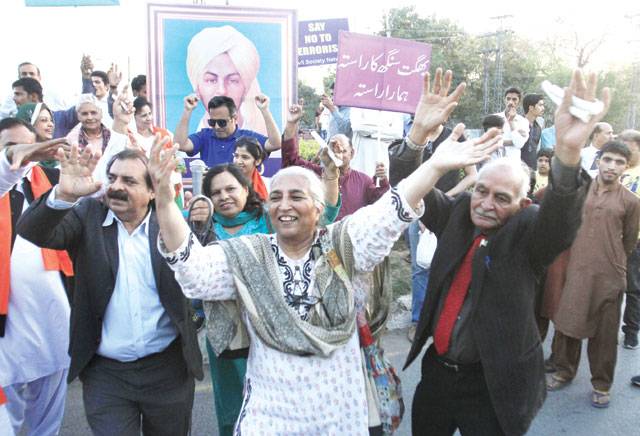LAHORE - Two events were held at Shadman Chowk on Friday to mark Bhagat Singh’s death anniversary.
Bhagat Singh Foundation Pakistan and a civil society organisation observed the 87th death anniversary of Bhagat Singh, Raj Guru and Sukh Devtoda at Shadman Chowk. A candle lit vigil was held to remember the legend. The participants were carrying placards in their hands with slogans of peace.
Speakers addressing the gathering said people of this subcontinent will never forget the courage and sacrifice of Bhagat Singh and his companions.
Bhagat Singh Foundation Pakistan founder President Abdullah Malik said, “We are observing Bhagat Singh Day as protest against fundamental policies of Indian Prime Minister Narendra Modi who is ruining peace in the region. Bhagat Singh raised his voice against imperialism and unlawful occupation of the subcontinent by the British Government and he will be remembered as a great freedom fighter,” Malik said.
Malik criticized the Punjab government, which promised to rename Shadman Chowk as Bhagtat Singh Chowk, but later withdrew this proposal.
Samson Salamat, Amna Ulfat, Aman Malik, Tanzeela Imran, Sh Pervaiz, Bishop Shahid Meraj Fayyaz Alam and Sikh students spoke the occasion and paid rich tributes to Bhagat Singh.
Bhagat Singh Memorial Foundation also arranged a function at Shadman to pay tribute to the freedom fighter.
Bhagat Singh read 300 books during his imprisonment of 716 days. He was hanged along with his three companions on March 23, 1931 at the Central Jail, which was located at Shadman Chowk at that time.
Bhagat Singh’s family was ideologically committed to revolutionary ideas and his revolutionary ideas brewed when he was just 12-year-old and saw the massacre of Jallianwala Bagh on April 13, 1919. British General Dyer had ordered his troops to open fired at people demanding freedom.
Bhagat Singh was fond of reading books and novels and according to some historians he read 300 books during his imprisonment of 716 days from April 8, 1929 to March 23, 1931. He was 23 years, five months and 25 days old when he was hanged. He was reading Russian statesman Vladimir Lenin's book, ‘State and Revolution’ hours before his hanging.
Bhagat Singh along with his comrade Sukhdev shot dead JP Saunders in a case of mistaken identity on December 17, 1927. The duo originally wanted to kill superintendent of police James Scott to avenge the death of freedom fighter Lala Lajpat Rai. Lajpat Rai was resident of Karishan Nagar, Lahore and in 1928 he was protesting against the British Government Commission headed by Sir John Simon. He died due to the injuries he received in the baton charge during that protest on the orders of James Scott.
The plan failed when the duo mistakenly assassinated 21-year-old British police officer. To avoid the arrest Bhagat Singh fled to Calcutta from Lahore. And later he and another comrade threw bombs at the Indian Central Assembly Hall in Delhi on April 8, 1929. He coined the term ‘Inquilab Zindabad’.
Apart from his political views, Bhagat Singh was an atheist and did not believe in existence of God. He even wrote an article ‘Why I am an atheist?’ to press his argument in non-existence of God.
He was born in 105 GB Banga village in Jaranwala, Faisalabad and moved to Lahore to study at the National College set up in the famous Bradlaugh Hall on Rattigan Road run by Lala Lajpat Rai.
After his hanging, people demanded his body so they could pay tribute to him but according to historians his body was chopped and cremated in Hussainwala village, which was located in Kasur district, but it was later given to India in exchange for 12 villages next to Sulemanki Headworks. His Samadhi can be seen across the Ganda Singh Border, Kasur.






